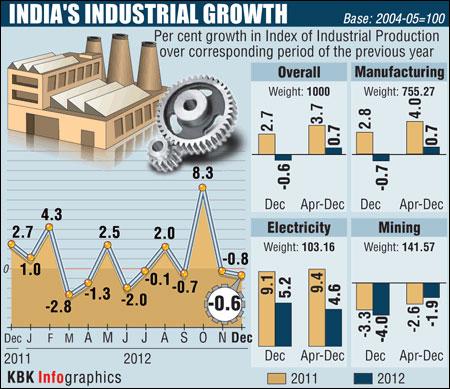Photographs: Reuters Subir Roy
Achieving high growth is meaningless if it doesn't translate into better human development outcomes, writes Subir Roy
The slide in India's growth rate over the last five quarters, with the figure for the current year (2012-13) now projected to touch a 10-year low of five per cent, has thrown those who used the gross domestic product benchmark in the past to claim exceptional performance into a tizzy.
Finance ministry and Planning Commission bigwigs are blaming the messenger, the Central Statistics Office.
The number keepers, for their part, have replied: we look at the past and project it into the future in a linear way; if the trend has changed, we cannot spot that right away.
A comprehensive model that takes into account macroeconomic cycles should have some sense if an inflexion point has been reached.
. . .
Complete coverage: Union Budget 2013-14
Budget Impact Live!
Do more with less GDP
Photographs: Reuters
The CSO implicitly does not have o#8800 but the finance ministry, with or without one, has equipped itself with remarkable prescience to claim there has been a turning point.
Even sophisticated models sometimes do not deliver, as was the case with the change in the global scenario in 2008.
No one, not even the US Federal Reserve, foresaw what was coming.
A far better longer-term position for the government would have been to acknowledge that India's GDP figures are highly imperfect.
Both good and bad numbers can then be taken with a pinch of scepticism until at least medium-term trends become clear and outliers are easily identified.
Ever since industrial licensing and related reporting compulsions were dispensed with, the index of industrial production has become rather unreliable and industrial growth figures have had to be drastically revised when the annual survey of industries is available with a time lag.
. . .
Complete coverage: Union Budget 2013-14
Budget Impact Live!
Do more with less GDP
Image: Border Security Force soldiers on camels in New Delhi.Photographs: B Mathur/Reuters
As for initial estimates of the services sector, they are even more unreliable, given the way price deflators are used to arrive at real values.
The anecdotal story goes that when a finance ministry official tried to dig a little deeper, his counterpart in the department of statistics famously cautioned: "If you try to look too much into the kitchen, you will not be able to eat the food."
As for revisions, here is an example. On the basis of 8.4 per cent growth in 2010-11, the government considered the 7.9 per cent growth achieved in the 11th Plan as 'laudable' and felt that an eight per cent target for the 12th Plan may be 'ambitious'.
But with the revision of the 2010-11 figure to 9.3 per cent, the relevant adjectives may have to be changed to 'highly laudable' and 'over ambitious'!
. . .
Complete coverage: Union Budget 2013-14
Budget Impact Live!
Do more with less GDP
Photographs: Catherine Benson/Reuters
Where there is not much doubt over figures, changes are easy to explain.
If growth in exports, which account for a quarter of GDP, is down from 21 per cent in 2011-12 to negative in the current year, then that will likely impact demand and overall growth.
If growth in agriculture, which accounts for a fifth of GDP, is down by half, then that will obviously impact overall growth.
So GDP growth rate projections should not be dismissed out of h#8743 instead, they should be treated with a degree of circumspection.
GDP or national income figures can be put in the right perspective if we see them as one element, among other human development indicators, which go into determining the overall level of well-being compositely captured in the human development index.
. . .
Complete coverage: Union Budget 2013-14
Budget Impact Live!
Do more with less GDP
Even here there is a need for caution.
The complexion of a nice-looking GDP can change if we find that its distribution has been very skewed.
A little change in income at the bottom, along with a sharp rise at the top, can leave poverty levels unchanged.
Income growth is not an end in itself, but a means to an end.
It depends on how additional income is used, which depends on issues of culture such as status of women and food habits, and the quality of governance.
Public spending on health care and education can go up, but if delivery is poor and the system leaky then the result will be below expectations.
The dissonance between income and human development is clear from the widely noticed comparison between India and Bangladesh.
. . .
Complete coverage: Union Budget 2013-14
Budget Impact Live!
Do more with less GDP
Photographs: Reuters
The latter is now ahead of India in most human development indicators, but lags in income.
What policy lessons follow?
While reforms were needed and have reduced the extent of bad government in our system, our policy makers suffer from some income fetishism, even when quick measures of income are not so robust.
(Income numbers need to be revised but data on birth, death, age, weight of children, years of schooling are more reliable.)
Achieving high growth is meaningless if it does not translate into better human development outcomes.
So, concentrate on governance and social-sector delivery, so that you can do more with less.








article